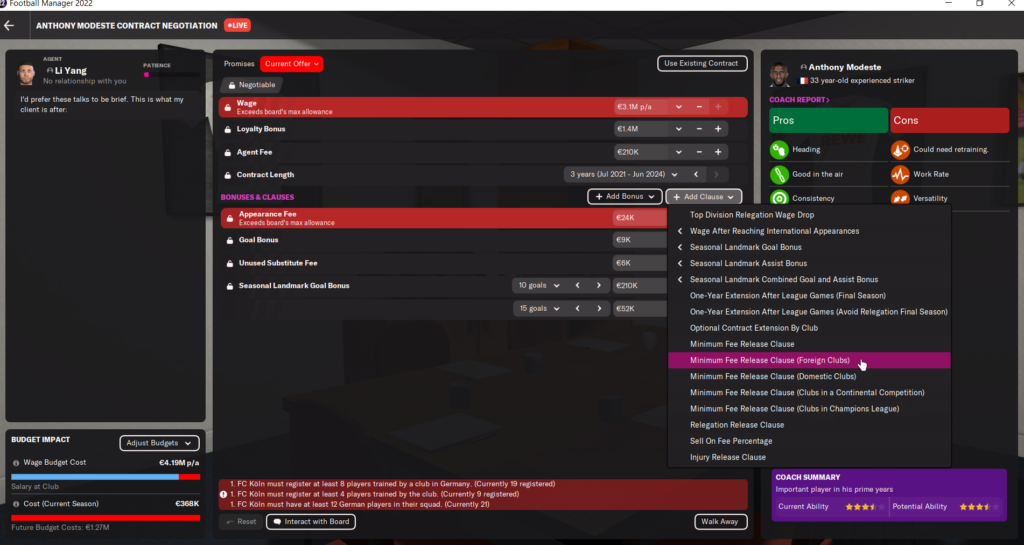
Done Deal – Contract Negotiation in Football Manager
Whenever we hear about a new signing to be made in real life or when we’re looking for players to add to our team in FM, the focus of the matter is always on the transfer fee. However, the amount of money interchanged between clubs is hardly the only economic part of the deal; clubs also have to settle on a contract with the player. That’s why it’s every bit as important to secure a good deal on both negotiation tables. Let’s take a look at the ins and outs of contract negotiation in Football Manager to get ourselves the best deal possible.
The Basics
Before we go in-depth into the big picture of contract negotiation, let’s take a look at the different clauses and terms that are included.
Promises

First, you get to the Promises part of the negotiation. In general, I recommend offering the lowest Playing Time possible, even if you know the player is going to be a big part of the upcoming season. This is simply because you never know what may happen the next day. If, for whatever reason, you’re unable to offer a player the same playing time as you originally thought you would; this gives you the room to manoeuvre without it becoming an issue.
This is also the first deal-breaker to be dealt with. If a player arrives at the negotiations table looking for an amount of playing time I can’t give them, I’ll walk away. No point in furthering conversations with a player who overestimates his value, as it is bound to cause trouble later.
You can also offer a player a progression in Playing Time and other niceties to further your case. I rarely use these; in my mind the prospect of playing for my team should be the only encouragement any player needs. However, I won’t deny them when a player asks for them (unless they may cause issues, like the one that promises a player to be used in a particular spot and role). It’s simply a matter of not shooting yourself in the foot. Be careful with the promise to “allow the player to use the club as a stepping stone”; it is useful when you’re trying to tempt a player with huge upside to joining your club (often planning to outperform and convince them to stay); however, it can force a very low Release Clause in their contract, which will put you in a very bad spot.

Contract Terms
Once you’re on the contract details screen, you’ll be able to negotiate the juicy bits, the economic terms. The Wage is, obviously, the amount paid every period; you can choose what that period is, something I’ll speak about a bit later. Then you have the Loyalty Bonus which is the amount paid for signing a contract renewal; if its a signing a new signing, you’ll pay a Signing on Fee. Both of these are paid throughout the deal, not instantly. After that, you have the Agent Fee, the amount paid to the agent, if there is one. Finally, the Contract Length is of course the amount of time the contract lasts; the the aforementioned bonuses will be paid over this period.
After that, you have the bonuses and clauses. Bonuses, as their name indicate, are extra payments made on the achievement of a given task. They range from appearing in a match to winning a competition. Clauses generally affect the economic terms of the contract; for example they provide for increments on the Wages or stipulating contract extensions on several criteria.
Contract Terms
Wages
Wages are probably the most important part of the contract. It’s the money your club will be investing into the player. As such, it’s key that you don’t overpay for any player; that’s simply money you could be used to further improve your squad, or simply save for other expenses.
As you can see, I like using yearly wages. The reason for this is one of equivalency; with yearly wages, your transfer budget and your wages budget will translate (roughly) one to one. This, of course, is not precisely how it works. In Business lingo, these are OPEX (Operational Expenditures) and CAPEX (Capital Expenditure). Your CAPEX (in this case, the transfer budget) is the money you use to buy assets, in this case, footballers. Your OPEX (the wage budget) is the cost of keeping said assets running, i.e. paying your players. Businesses are often vigilant of their OPEX, as going overboard is bound to bring problems, whilst the CAPEX is much more flexible. Since these are two, very different budgets, they work independently of one another. However, using yearly wages you can have an approximation of how they could be interchanged; having €500k remaining in your transfer budget will give you around €500k more in your wage budget, should you need it.
Calculating Wages
So what should you pay your players? If you go to the Finances menu, open the Wages tab and select Summary, you’ll see a list of what each of your players should be paid according to the playing time they’re supposed to receive. This is only a guideline, but it’s worth checking out, particularly if you’re managing in a league in which you have no previous experience. As a rule of thumb, you should never pay higher than your highest current wages unless you’re bringing a player that will be a big upgrade when compared to your current squad.
However, that may change depending on the situation. For example, if you’re signing a player from a lower reputation league, or offering a top prospect their first professional contract, you’re probably going to pay less. My advice is to always underpay when the chance exists. This may sound a bit cheap, but the truth is you’re paying for an unproven asset. That’s the case, regardless of how sure you may feel as to their future performance. Worry not, however, as the market is bound to work its magic; soon you’ll have those players asking for their just rewards when they achieve the reputation and performance expected of them
Of course, wages are the second deal-breaker. No player is worth paying more than they’re worth, regardless of whether your club can afford it, their quality, their potential or otherwise.
Signing on Fee/Loyalty Bonus & Agent Fee
These are fairly straightforward as they’re often not the key area of negotiation. As a rule of thumb, I try to keep Signing on Fees to a year’s wages or below, while Loyalty Bonuses to around half that. When a player is joining in without a Transfer Fee, this may rise as it is often the player who will receive the money.
For Agent Fees, I try to keep them to a tenth part of the previously mentioned fee. Some agents will require more, which should not be a stumbling block for your deal unless they’re asking for unreasonable amounts of money. When I negotiate with a player who has no agent (a very common occurrence in the lower leagues), I’ll add this percentage to the Signing on Fee/Loyalty Bonus, as another incentive for the player to sign.
Contract Length
The time on a contract is often a tricky business. Too short and you might lose the player for nothing; too long and you might get stuck with a player that you can’t get rid of, should things not work out. Also, at times clubs will ask to keep players with several years on their contracts. I try to keep all starter and rotation players with at least two years on their contracts. That way, when I decide I no longer want a player (or they decide they no longer want to play for the club), we can shift them at a decent price, or loan them out for two seasons should they find no bidders.
When signing a new player, I’ll try to get at least three years; if I’m signing a young player with decent upside, I’ll aim for four or more. As players cross the barrier of thirty, I’ll offer shorter contracts. This is because players, while rarely too stubborn to take a reduced deal when the time has come will refuse to negotiate until their current deal is on its last legs. If you sign a 30-year-old to a four-year contract, he might still be a useful player by the end of the contract, but he’ll be prohibitively expensive. If you sign him to two, two-year contracts, you’ll be able to lower their wages on average.
Ageing Players
When dealing with ageing players, it’s also worth taking notice of two clauses you can add. First, the one that gives you the option to add a year to the contract, as it gives you the ability to extend the contract of a player you deem fit to continue playing. There’s also a clause that allows you to end their contract should the player receive a long term injury. This can be worthwhile as extended injuries (6 months or more) will wreak havoc on any player’s physical attributes, but particularly to ageing players, where that’s already an issue.
Bonuses
Bonuses are a vital way of “greasing” the wheels of negotiations, and some are so prevalent they might as well be part of the regular contract. First, you have those which I call “Performance Bonuses”, Appearance Fee, Goal/Assist/Clean Sheet Bonus and Unused Substitute Fee. Of those three, I usually only give players the first two, and only one of the stats driven bonuses. For example, I’ll give a striker an Appearance Fee and a Goal Bonus, but not all three. Generally, I calculate these at 0.5% of their yearly wages; this provides a good correlation between their importance to the team and the money they get. I never give players an Unused Substitute Fee, on principle; I simply don’t think you should get paid to sit on your bum for 90 minutes.

Competition and Other Bonuses
Then, there are the Competition Bonuses, bonuses paid for the team achieving a given goal. I try to be generous with these, as they often correlate with the club’s own goals, and carry prize money or access to top competitions. I’ll generally add prizes for winning the league and any cups we’re taking part in, capped at 10% and 5% respectively. Players joining a club with their sights on entering a continental competition will often ask for a bonus for achieving said qualification.
Last but not least, you have other bonuses like Team of the Year bonus, Top Goalscorer bonus and International Cap bonus. I’ll grant these if a player requests them, but never add them of my own volition. I cap them at 5% of the yearly wages. When it comes to the International Cap bonus, it can be an interesting tool, particularly for players looking from the outside in to making it to their national team. However, be careful when adding it for players from lower reputation countries; they may get called every single time, making it pretty much a fixed part of their wages.
Clauses
Performance Clauses
Unlike Bonuses, Clauses often come with serious implications. We’ll get out of the way the least clause-like Clause, the Seasonal Landmark bonuses, often given for goals, assists, etc. I’ll never add these, and fight to keep them off a contract unless players are very insistent. This is simply because most of the time my players are on Performance Bonuses; this would mean they would effectively get paid twice for the same goals; they’re also quite hefty and players/agents like to set very low thresholds for them, meaning they should be fired more often than not.
Wage Clauses
Next, we have what we’ll call “Wage Clauses”, clauses that alter the wages a player is agreed to. Players joining clubs in the lower leagues will often ask for a Promotion Wage Rise; these are dangerous, as they will hamper your ability to sign players after said promotion if every player has one. I try to cap them at 15% and eliminate it if possible. There also exists the Relegation Wage Drop; however, these are less of a topic. For once, you’re likely to get the sack in case of relegation, which means it’ll simply be someone else’s problem; in any case, players coming from a higher division will often get poached by their former rivals. That way you can discount those wages regardless.

You also have the “Yearly Wage Rise” clause, which does exactly what it says on the cover. These are often requested by young players who are signing lower contracts; I steer clear from them at almost all costs. Simply put, you never know what may happen in a few seasons’ time; why have this increasing cost on a player that’s not worth it at the present? I’ll pay a slightly higher wage from the get-go and save myself this increasing cost; I may end up paying a higher average, but I like having things set in stone. However, it’s a matter of personal preference.
Releases Clauses
Last but not least, we have the elephant in the room, the Release Clauses. I’ll go ahead from the get-go and admit I don’t mind the Release Clause unless it’s forced at a low number by a greedy agent upon me (that is, by the way, my third deal-breaker). Most people who refuse to include Release Clauses in contracts worry about their players leaving without further notice when a club matches that price; however, they’re just another tool in the box and can be very handy when properly used. For example, let’s say you have a player who wants to leave. They have clubs interested, so offers arrive but you reject them. The player may want a word, angry at you blocking their exit. But, here’s the thing… They have a release clause, a price for which any club can buy them, and one to which they agreed.
More often than not, that will shut the player off, as they can’t argue you’re being unfair when their sale price is specified on the contract. Whether they match said figure and leave or they remain is a whole different issue: much in the same way they can lose you a player without notice, Release Clauses can stop clubs from poaching your players on the cheap.
Domestic and Foreign
I generally use and consider two kinds of Release Clauses, Domestic and Foreign. I often calculate a standard clause, which I rate at 50x the yearly wages. Then I set a Domestic Release Clause at 150% of that initial clause, and Foreign Release Clauses at 75%. My reasoning is I’d much rather lose a player to a foreign club than to a domestic rival. That is particularly the case when managing in leagues where I’m not the biggest fish in the bowl. If I’m managing a top club but it’s in a lower reputation league, I’ll set instead the standard Relegation Club. More often than not it means I can get that extra money; most of my domestic rivals simply can’t afford it anyway. This way, clauses are calculated so that, should a club trigger any of them, I get enough money to buy a replacement and keep the difference to invest in other areas.
High End vs Low End Negotiating
Several strategies are worth remembering, depending on whether you’re negotiating contracts on the high end of the footballing world’s spectrum, or at its lowest. For a matter of clarity, I consider high-end to be any negotiation done at the helm of professional clubs playing in high reputation leagues, while low end are those done on behalf of semi-pro or barely professional clubs, deep on the pyramids of leagues. It might not be the same to cut a deal while managing Borussia Dortmund as to do so as Charlton Athletic, but it sure has a lot more in common than negotiating as the manager of Concord Rangers.
Low end clubs will often deal in shorter contracts; their situation is far more volatile and shouldn’t commit to longer-term deals. As well, Performance Bonuses, particularly Apparence Fees, are more important to players. They represent a far larger percentage of their overall income. When it comes to semi-pro clubs, you’ll also have to watch closely the overall cost of each contract; it’s not calculated out of the regular wages (since these don’t exist), but rather out of the fees and bonuses a player is offered.
For high end clubs, signing fees and higher regular wages become a key factors. Players are less likely to want longer contracts, as this limits the amount they can earn. It’s also here that most of what we’ve discussed regarding bonuses and clauses apply. This because there is a lot more going on about the value of each player.
Closing Comments
The negotiation of a contract can and will influence what your club will get out of each player. I’m not saying I’m the best negotiator out there; We’ve all had that moment when we can’t get rid soon enough of a player we were eager to bring on just twelve months back. But hopefully, this guide will help you get the best of contract negotiation in Football Manager so you can reduce those cases to a bare minimum.
Enjoyed this? Here are other articles for you:
Total Football Journeyman: Story of One Bulgarian in Spain
Total Football Journeyman: Creating My 4-3-3/4-2-3-1 Hybrid
FM22: What Makes a Good Director of Football?
FM22: What Makes a Good Goalkeeping Coach?
Scoring Tips for Struggling Teams in Football Manager
One thought on “Done Deal – Contract Negotiation in Football Manager”